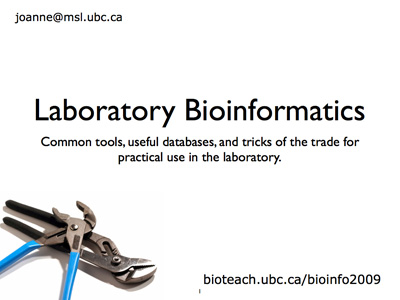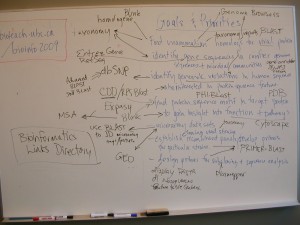LABORATORY BIOINFORMATICS WORKSHOP 2009
This workshop focuses on bioinformatics techniques for practical use in the laboratory. Hands-on exercises for retrieving data, primer design, BLAST searching, and genomics data navigation are covered. Primarily aimed at researchers who are new to the area, or familiar but require a quick updating, where content covered can be tailored to laboratory needs.

2009 Workshop Participants describe the workshop:
A fairly intensive course that managed to achieve a good mix between overview information and in depth details. Therefore, it highly recommendable for scientists who are new to the field of bioinformatics and provides and ideal starting point to gain further practical knowledge using bioinformatic tools. It also provided information specific to participants individual requirements.
Incredible way of fast learning about the most popular bioinformatics tools available, as well as practical examples that open a big world of ideas of how to make research. I feel much more confident now that I can quickly hone in on pertinent information and understand what I retrieve. This workshop was extremely valuable in calling my attention to many of the resources available in the public domain and how to use features I was not previously aware of. It is worth the time for this workshop!
All of the course materials for this workshop are available online. An updated version of the Laboratory Bioinformatics Workshop materials are also available here for WABWS workshop participants.
![]() WABWS Laboratory Bioinformatics Modules
WABWS Laboratory Bioinformatics Modules
Jump to:
Day 1
Day 2
Day 3
Links
Day 1 – Links, References & Supplementary Readings
What is Bioinformatics?
Fox J. http://www.scq.ubc.ca/what-is-bioinformatics/
Public Database Resources
National Center for Biotechnology Information
http://www.ncbi.nlm.nih.gov/
Database resources of the National Center for Biotechnology Information.
Wheeler DL et al. Nucleic Acids Res. 36 (2008) D13-D21. [PMID: 18045790]
The “About Entrez” page at the NCBI
http://www.ncbi.nlm.nih.gov/Database/index.html
Model of Entrez Databases from NCBI
http://www.ncbi.nih.gov/Database/datamodel/index.html
PubMed Tutorial from NLM
http://www.nlm.nih.gov/bsd/pubmed_tutorial/m1001.html
Practical Exercises:
- Entrez Database Searching Scenario
- Retrieve records annotated with a given biological feature (e.g., promoter)
- Exercises to try on your own
You notice a gene of interest in the literature and you want to find out more…
![]() Entrez Database Searching Scenario
Entrez Database Searching Scenario
This Sample GenBank Record gives a detailed description of each field in a GenBank record. For this exercise, you will try two search approaches. Approach A begins in the Entrez Nucleotide database while Approach B begins in the Entrez Gene database
![]() Retrieve records annotated with a given biological feature (e.g., promoter)
Retrieve records annotated with a given biological feature (e.g., promoter)
Adapted from: NCBI Advanced Workshop for Bioinformatics Information Specialists
DAY 2 – Links, References & Supplementary Readings
Sequence Similarity Searching
BLAST: Basic Local Alignment Search Tool
http://www.ncbi.nlm.nih.gov/blast/Blast.cgi
Basic local alignment search tool.
Altschul SF, Gish W, Miller W, Myers EW, Lipman DJ J. Mol. Biol. 215 (1990) 403-410. [PMID: 2231712]
Gapped BLAST and PSI-BLAST: a new generation of protein database search programs.
Altschul SF, Madden TL, Schaeffer AA, Zhang J, Zhang Z, Miller W, Lipman DJ Nucleic Acids Res. 25 (1997) 3389-3402. [PMID: 9254694]
NCBI BLAST: a better web interface. Johnson M, Zaretskaya I, Raytselis Y, Merezhuk Y, McGinnis S, Madden TL Nucleic Acids Res. 36 (2008) W5-W9 [PMID: 18440982]
Designing and Testing Primers with NCBI’s Primer-BLAST:
NCBI Primer-BLAST service:
http://www.ncbi.nlm.nih.gov/tools/primer-blast/
General Concepts for PCR Primer Design.
Dieffenback CW, Lowe TMJ, Dveksler GS Genome Research 3 (1993) S30-37 [PMID:8118394]
Looking for help with the advanced parameters of Primer-BLAST?
Try the Primer3 help page.
Multiple Sequence Alignments – Comparing Sets of Protein Sequences
ClustalW2 is a general purpose multiple sequence alignment program for DNA or proteins.
http://www.ebi.ac.uk/Tools/clustalw2/
MUSCLE stands for MUltiple Sequence Comparison by Log-Expectation.
http://www.ebi.ac.uk/Tools/muscle/
T-Coffee is a multiple sequence alignment program that will allow you to combine results obtained with several alignment methods.
http://www.ebi.ac.uk/Tools/t-coffee/
Expasy Proteomics Server, a server dedicated to the analysis of protein sequences and structures.
http://ca.expasy.org/
- Basic BLAST:
- Searching with sets of sequences and/or with small custom databases:
- Primer BLAST:
- Generate a Multiple Sequence Alignment with Globin proteins
- Exercises to try on your own
An astonishing techique for recovering and cloning dinosaur DNA has been discovered. Now mankind’s most thrilling fantasies have come true. Creature extinct for eons roam Jurassic Park with their awesome prescence and proufound mystery, and all the world can visit them — for a price. Until something goes wrong …
![]() DinoDNA from JURASSIC PARK p. 103 nt 1-1200
DinoDNA from JURASSIC PARK p. 103 nt 1-1200
![]() DinoDNA from THE LOST WORLD p. 135
DinoDNA from THE LOST WORLD p. 135
A salmonid EST genomic study: genes, duplications, phylogeny and microarrays.
Koop BF, von Schalburg KR, Leong J, Walker N, Lieph R, Cooper GA, Robb A, Beetz-Sargent M, Holt RA, Moore R, Brahmbhatt S, Rosner J, Rexroad CE, McGowan CR, Davidson WS BMC Genomics 9 (2008) 545 [PMID: 19014685]
![]() FASTA file with Salmon ESTs from Koop et al.
FASTA file with Salmon ESTs from Koop et al.
![]() Zebrafish hemoglobin alpha adult-1 (hbaa1)
Zebrafish hemoglobin alpha adult-1 (hbaa1)
NCBI now offers Primer-BLAST, a Web service for designing target specific oligonucleotide primers for use in PCR protocols. This service integrates primer designing code from the popular Primer3 software with a specificity check that uses a custom BLAST search.
source: NCBI News, November 2008
![]() Use Primer-BLAST to design primers for UNG transcript variant 2
Use Primer-BLAST to design primers for UNG transcript variant 2
![]() Save this file to your desktop.
Save this file to your desktop.
DAY 3 – Links, References & Supplementary Readings
Accessing Genome Annotations with Genome Browsers
UCSC Genome Browser
http://genome.cse.ucsc.edu/
Ensembl Genome Browser
http://www.ensembl.org/index.html
NCBI Map Viewer
http://www.ncbi.nlm.nih.gov/projects/mapview/
Public Databases for Microarray
Gene Expression Omnibus
http://www.ncbi.nlm.nih.gov/geo/index.cgi
Pathway Resources for Systems Biology
Pathguide: the pathway resource list
http://www.pathguide.org/
Pathway Commons is a convenient point of access to biological pathway information collected from public pathway databases, which you can browse or search.
http://www.pathwaycommons.org/pc/
Cytoscape is an open source bioinformatics software platform for visualizing molecular interaction networks and integrating these interactions with gene expression profiles and other state data.
http://cytoscape.org/
Pathway information for systems biology.
Cary MP, Bader GD, Sander C. Febs Lett 8 (2005) 1815-20 [PMID: 15763557]
Laboratory Bioinformatics Links:

The essentials:
NCBI – http://www.ncbi.nlm.nih.gov/
BLAST – http://blast.ncbi.nlm.nih.gov/Blast.cgi
NCBI Primer-BLAST – http://www.ncbi.nlm.nih.gov/tools/primer-blast/
Primer3 http://frodo.wi.mit.edu/primer3/input.htm
ClustalW2 http://www.ebi.ac.uk/Tools/clustalw2/
MUSCLE http://www.ebi.ac.uk/Tools/muscle/
T-Coffee http://www.ebi.ac.uk/Tools/t-coffee/
Expasy http://ca.expasy.org/
UCSC Genome Browser http://genome.cse.ucsc.edu/
Ensembl Genome Browser http://www.ensembl.org/index.html
NCBI Map Viewer http://www.ncbi.nlm.nih.gov/projects/mapview/
GEO http://www.ncbi.nlm.nih.gov/geo/index.cgi
Pathguide http://www.pathguide.org/
Pathway Commons http://www.pathwaycommons.org/pc/
Cytoscape http://cytoscape.org/
Useful utilities:
PlasMapper: a web server for drawing and auto-annotating plasmid maps. Dong X, Stothard P, Forsythe IJ, Wishart DS Nucleic Acids Res. 32 (2004) W660-664. [PMID:15215471]
Are you looking for a bioinformatics tool that’s not covered here?
Search the Bioinformatics Links Directory:
http://bioinformatics.ca/links_directory/index.php
Keeping pace with the data: 2008 update on the Bioinformatics Links Directory. Brazas MD, Fox JA, Brown T, McMillan S, Ouellette BFF Nucleic Acids Res. 36 (2008) W2-W4. [PMID: 18586831]
